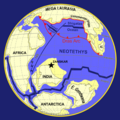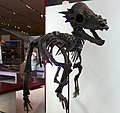The Cretaceous–Paleogene (K–Pg) extinction event, also known as the K–T extinction, was the mass extinction of three-quarters of the plant and animal...
196 KB (21,658 words) - 00:32, 8 May 2025
amount of research has been conducted on the Cretaceous–Paleogene extinction event, the mass extinction that ended the dinosaur-dominated Mesozoic Era...
119 KB (12,560 words) - 19:36, 14 May 2025
043 Ma. The K–Pg boundary is associated with the Cretaceous–Paleogene extinction event, a mass extinction which destroyed a majority of the world's Mesozoic...
30 KB (3,110 words) - 21:39, 22 March 2025
early Paleogene, as survivors of the Cretaceous–Paleogene extinction event took advantage of empty ecological niches left behind by the extinction of the...
68 KB (7,535 words) - 17:26, 8 March 2025
Cretaceous (along with the Mesozoic) ended with the Cretaceous–Paleogene extinction event, a large mass extinction in which many groups, including non-avian dinosaurs...
95 KB (9,957 words) - 13:27, 14 May 2025
ecological impacts associated with the Permian–Triassic and Cretaceous–Paleogene extinction events. Furthermore, biotic recovery from LOME proceeded at a much...
102 KB (11,111 words) - 02:10, 4 May 2025
impact 66 million years ago, believed to be the cause of the Cretaceous–Paleogene extinction event. Small objects frequently collide with Earth. There is an...
116 KB (12,785 words) - 17:43, 10 May 2025
was wiped out in the Cretaceous-Paleogene extinction event; only 3 extant tetrapod lineages can trace their ancestry to Cretaceous India. Most of India's...
30 KB (3,772 words) - 02:12, 16 April 2025
impact event may have caused the Cretaceous–Paleogene extinction has led to speculation that similar impacts may have been the cause of other extinction events...
381 KB (40,884 words) - 02:13, 16 May 2025
Danian (section Latest Danian Event)
(and the end of the preceding Maastrichtian) is at the Cretaceous–Paleogene extinction event 66 Ma. The age ended 61.66 Ma, being followed by the Selandian...
14 KB (1,393 words) - 19:36, 22 March 2025
Mesozoic (section Cretaceous)
extinction event, the largest mass extinction in Earth's history, and ended with the Cretaceous–Paleogene extinction event, another mass extinction whose...
42 KB (4,408 words) - 02:08, 11 May 2025
dinosaur such as Stenonychosaurus had not perished in the Cretaceous–Paleogene extinction event, its descendants might have evolved to fill the same ecological...
10 KB (1,135 words) - 15:24, 16 March 2025
mass extinctions have significantly exceeded the background extinction rate. The most recent and best-known, the Cretaceous–Paleogene extinction event, which...
147 KB (15,049 words) - 22:31, 16 May 2025
willows could be found in abundance. The Cretaceous–Paleogene extinction event was a large-scale mass extinction of animal and plant species in a geologically...
18 KB (1,691 words) - 10:29, 8 May 2025
Maastrichtian (category Late Cretaceous)
province in the Netherlands. The Cretaceous–Paleogene extinction event (formerly known as the Cretaceous–Tertiary extinction event) occurred at the end of this...
20 KB (1,823 words) - 19:11, 17 December 2024
Titanoboa (category Paleogene Colombia)
following the extinction of all non-avian dinosaurs, being one of the largest reptiles to evolve after the Cretaceous–Paleogene extinction event. Its vertebrae...
30 KB (3,391 words) - 19:16, 1 May 2025
Alvarez hypothesis (redirect from Alvarez extinction hypothesis)
posits that the mass extinction of the non-avian dinosaurs and many other living things during the Cretaceous–Paleogene extinction event was caused by the...
21 KB (2,439 words) - 16:17, 5 May 2025
Chicxulub crater (category Cretaceous–Paleogene boundary)
resulting from the impact was the primary cause of the Cretaceous–Paleogene extinction event, a mass extinction of 75% of plant and animal species on Earth, including...
84 KB (8,211 words) - 01:11, 13 May 2025
Ammonoidea (category Paleocene extinctions)
with the last species vanishing during or soon after the Cretaceous–Paleogene extinction event. They are often called ammonites, which is most frequently...
55 KB (5,957 words) - 19:35, 13 May 2025
the Triassic–Jurassic extinction event. While other crocodylomorph groups further survived the Cretaceous–Paleogene extinction event, notably sebecosuchians...
118 KB (13,619 words) - 01:51, 17 May 2025
Australobatrachia, during the mid-Cretaceous. The fossil evidence found during the Cretaceous-Paleogene extinction event could not determine the effects...
13 KB (1,397 words) - 21:36, 26 April 2025
Geomagnetic reversal (redirect from Cretaceous Long Normal)
impact events is weak. There is no evidence for a reversal connected with the impact event that caused the Cretaceous–Paleogene extinction event. Shortly...
44 KB (4,927 words) - 22:18, 7 May 2025
species, Triceratops prorsus, became extinct during the Cretaceous–Paleogene extinction event, 66 million years ago. Triceratops is by far the best-known...
33 KB (3,065 words) - 00:56, 5 May 2025
the last-known non-avian dinosaurs and lived until the Cretaceous–Paleogene extinction event 66 million years ago. The name Triceratops, which means...
103 KB (10,800 words) - 18:06, 16 May 2025
Megafauna (redirect from Megafauna extinction)
mass increase for a ten-fold change. Subsequent to the Cretaceous–Paleogene extinction event that eliminated the non-avian dinosaurs about 66 Ma (million...
79 KB (8,096 words) - 23:36, 11 May 2025
various neoavian groups occurred very rapidly around the Cretaceous–Paleogene extinction event, and attempts to resolve their relationships with each other...
31 KB (1,398 words) - 06:31, 19 April 2025
last species of non-avian dinosaurs on Earth before the Cretaceous–Paleogene extinction event. The genus Tylosteus has been synonymized with Pachycephalosaurus...
48 KB (4,610 words) - 05:15, 7 May 2025
societies. Out of the "Big Five" extinction events in Earth's history, only the Cretaceous–Paleogene extinction event had occurred while angiosperms dominated...
81 KB (6,351 words) - 23:32, 4 May 2025
dinosaur from the future, sent back in time just prior to the Cretaceous–Paleogene extinction event. In the distant year of 4122, a dinosaur species, Nanosaurs...
8 KB (733 words) - 19:27, 11 February 2025

























